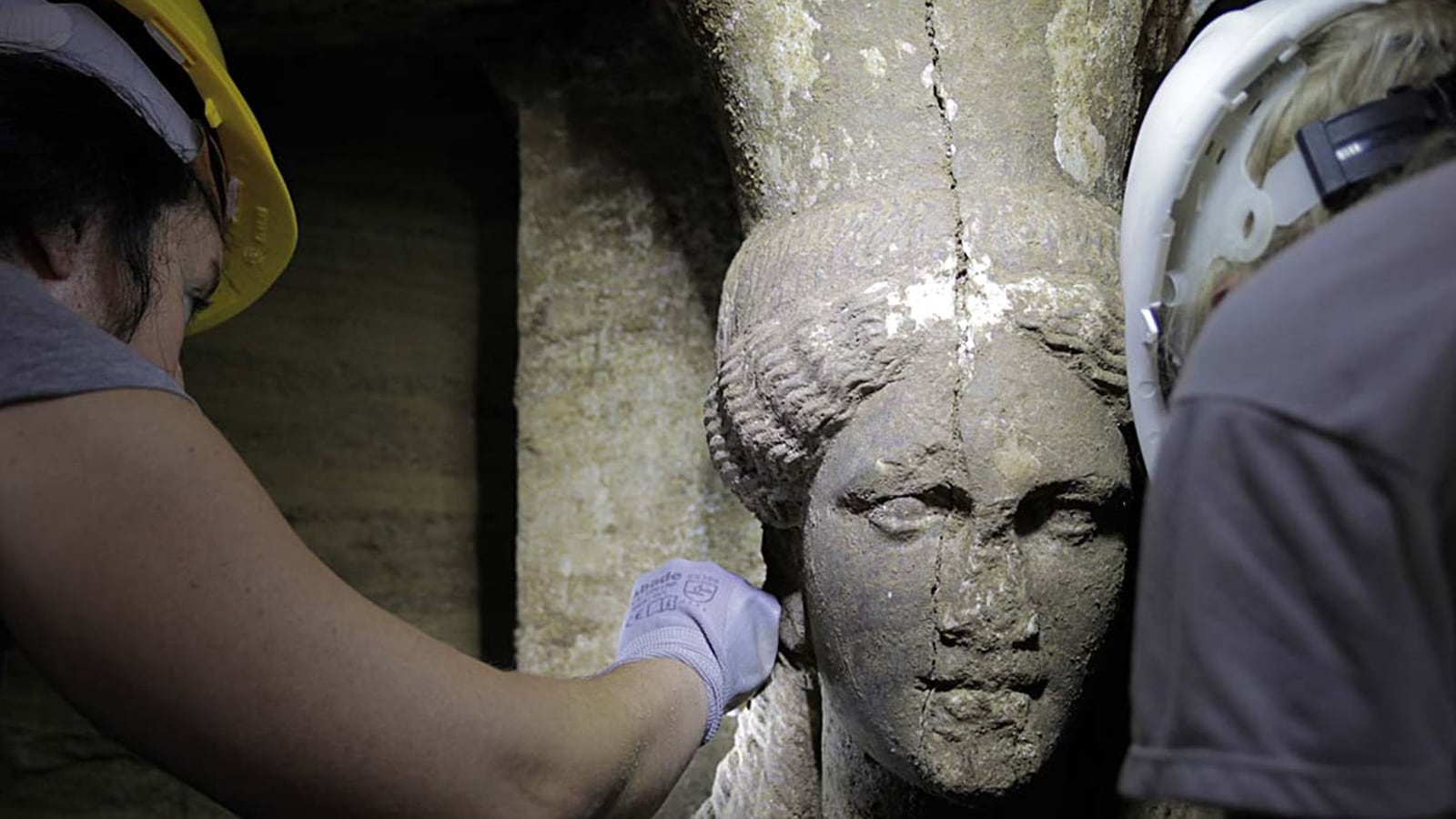Its entrances are guarded first by a pair of sphinxes, then by columns in the form of women—each stretching out an arm to ward off intruders. Beyond them lies one of the greatest mysteries of modern archaeology, one that might be solved in the next few days—or might trouble the sleep of scholars for decades, as the last great find in the territory of the ancient Macedonians, the nation once ruled by Alexander the Great, has done.
The structure that now holds much of Greece and Hellenists around the world in suspense stands at the site of ancient Amphipolis, about a hundred miles east of Thessalonica, on territory conquered by Alexander’s father Philip in the 4th century B.C. Amphipolis was a major Greek city and a stronghold of the vast Macedonian empire, but today the site is all but deserted. On grasslands where goatherds graze their flocks, under a hill called Kasta—now protected by a military cordon from throngs of onlookers—lies one of the most puzzling finds ever unearthed in the Aegean region.
Round in shape and vast in size, the building beneath the hill has been called a tomb for lack of a better label. Circular buildings, though rare in antiquity, were sometimes used for royal burials, but no other known tombs approach the scale of this one: 500 meters in circumference (half again larger than Stonehenge) and surrounded by a superbly built marble wall. Atop the center of the building’s roof once stood a crouching stone lion, long ago removed from the site but still intact—a sign that the tomb, if such it is, probably held a great soldier or ruler. The structure’s date, fixed by analysis of the lion and the stonework, seems to be the last quarter of the 4th century B.C., the decades just after Alexander’s death in 323.
Only Alexander himself, it would seem, could have merited such an enormous and expensive resting place, yet Alexander’s remains are known to have gone elsewhere—stolen by Ptolemy, the Macedonian ruler of Egypt, for interment in Alexandria and later visited by thousands. So unless an ancient legend is true, that Ptolemy swapped a dummy Alexander for the real one, the greatest corpse in the ancient world is already accounted for (at least until its unexplained disappearance many centuries later). So too, apparently, are the bodies of Alexander’s father and son, widely believed to be the occupants of two sumptuous tombs discovered, totally intact, in the late 1970s, near Vergina, on the site of what was once the Macedonian royal capital.
But those two identifications are still subjects of debate, a problem that adds to the suspense now mounting at Amphipolis. No inscriptions were found in the Vergina tombs, so a complex—and sometimes controversial—mass of evidence had to be analyzed before conclusions could be drawn. The Amphipolis site, even if its contents have remained undisturbed by robbers, could also yield a body or bodies that cannot be identified easily or with certainty. More troubling still is the prospect that, as some expect, Alexander’s son lies inside—a young prince killed at Amphipolis around 308 B.C. That finding would throw the hard-won and still contested analysis of the Vergina tombs into total disarray.
So who else might lie inside the great circle of the Amphipolis tomb? The betting at local tavernas, and Internet chatter worldwide, has focused on the so-called Successors, the Macedonian generals who carved up Alexander’s empire and made themselves kings of its pieces. Lysimachus and Cassander are the leading candidates among this crew, kings of the regions east and west of Amphipolis, though there are good reasons to eliminate both of them. Alexander’s mother, Olympias, has also been proposed, but the regime that tried and executed her in 317 B.C. had no reason to bury her so grandly. That leaves Roxane, Alexander’s famously beautiful Asian wife, who became a political prisoner shortly after Alexander’s death. Poisoned at Amphipolis by a ruler who wanted no rivals, Roxane was reportedly sent to the Vergina complex for burial, but no sign of her tomb has been found there.
The Amphipolis tomb may hold the remains of hundreds of bodies, or none at all. Some speculate it was a kind of war memorial, dedicated to the Macedonian soldiers killed during Alexander’s 13-year campaign of conquest. That theory would explain the sculpted lion that once crowned the building, a statue closely resembling one set up by the Macedonians on a battlefield in northern Greece. Others think it may be a cenotaph, built to house Alexander himself but then left empty after Ptolemy made off with his body. Either of these hypotheses would account for the size and magnificence of the building, which seem inexplicable under any of the other scenarios.
The drumbeat of anticipation keeps growing louder in the reports and photos streaming from Amphipolis. The pair of sphinxes atop the tomb’s main entrance were uncovered last month; after the chamber behind them was cleared of earth, a second gateway, flanked by the female-shaped caryatid columns, came to light only days ago. Behind this inner gate lies yet another antechamber and a third portal, presumably the entrance to one of the tomb’s main chambers. A small opening found in the interior wall has had experts worried that intruders may have plundered the tomb, but the aperture may also have been an exit route for those who interred the body, and then sealed the structure, some 2,400 years ago.
An announcement that archaeologists have entered a main chamber at Amphipolis may come at any time. Whatever is learned of what lies inside is certain to cause a sensation, because no one knows what to expect. Scholars at least know what they are hoping for—decisive evidence and clear answers. It’s what they didn’t get from the headache-filled finds at Vergina, still under dispute 37 years later.






